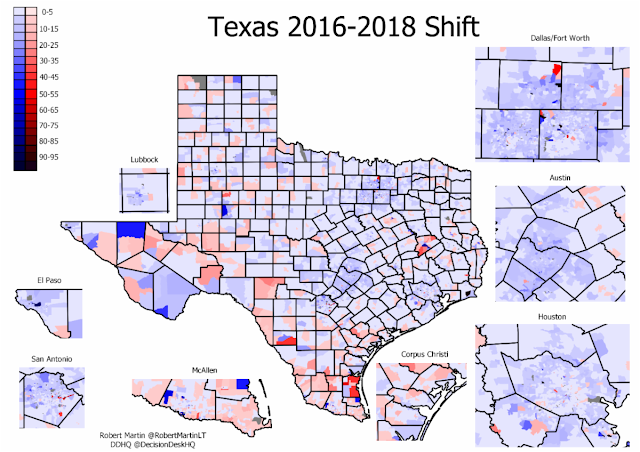(Note: This post is by Robert Martin from the Decision Desk HQ newsletter. I asked him if this was posted online anywhere; it isn't, so I posted it here)
One of the most common refrains of US elections is that the failure of the Beto O'Rourke campaign to win the Texas Senate race in 2018 against Ted Cruz means that Joe Biden will be similarly unable to do so in 2020 against President Trump. The view, informed by the fact that Beto raised more money than any other candidate in 2018 and that Ted Cruz was seen as a vulnerable candidate, has informed the consensus around the race. That Texas is just too red, and inelastic of a state to vote Democratic in 2020. However, when looking at the level at a more granular level, it becomes more and more clear that isn’t the whole story. That Beto made historic gains in the Lone Star State in 2018, but his inability to carry it wasn’t due to inelasticity, but a lack of enthusiasm and support of minority voters. Let’s redraw the map, and see where the data takes us instead of the common media narratives.
The above two maps are how everybody views 2016/2018, and to be fair, they are the most accurate representation of what happened. By coloring in the margins of where each candidate won, and by how much, we can see that areas where Clinton did well very clearly overlap with where Beto did well. Not only did Beto replicate Clinton’s map, but he also made large inroads into suburban Texas; Dallas, Houston, Austin, San Antonio, etc. This can be more accurately seen with the shift map from 2016-2018, as shown below.
This map clearly shows exactly where Beto did better than Clinton, and the suburban parts of Dallas, Houston and Austin are stand out as very large Democratic shifts from 2016. However, there are some problem areas in the map. One of the benefits of Beto in 2018 that Clinton didn’t have was that the environment was much more favorable for Democrats, D+8.5 instead of Clinton’s D+2 National environment. In this way, you should generally expect Beto to do 6.5 points better in every precinct. However, it is very clear from this map that didn’t happen, that Beto did better in some areas and worse in others. Most notable of all is the Rio Grande Valley, which is normally a Democratic bastion of support that not only had some small shifts to Beto in 2018, actually had many shifts against him in the particularly rural areas. Let’s look at another map, this time subtracting 6.5 to the shift from Beto, to see where Beto had an above average shift, and where he severely underperformed.
This second map is both very alarming and very promising to Democrats. It shows Beto making large inroads in Suburban Austin, Dallas and Houston. However, it shows a potentially large problem for Democrats, as Beto actually suffered a swing against him (given the change in National environment) in some of the most Democratic areas of the state (Downtown Dallas, Houston, and the Rio Grande Valley). How is this possible? Beto clearly energized a coalition of suburban college educated whites to support him over his GOP rival Ted Cruz, but clearly Hispanics that turned out to vote for Clinton decided to stay home, and as such the GOP share of the electorate as Hispanics that voted for Trump grew, as they now occupied a larger share of a smaller pool. Looking at this data, it is hard to argue that Cruz is only the Senator from Texas due to lower numbers of Democratic leaning Hispanic voters in the Midterms. Additionally, while on the surface the PVI of Texas appeared to not change from 2016-2018 (Texas still leaned to the right of the nation by 10 points in both elections) it is clear that the only reason that happened is because of the notional swing Beto suffered in the Rio Grande Valley and Downtown areas. If those minority voters had come out to vote, this article would be about Senator Beto O’Rourke, and how Texas is an elastic state due to their fast moving suburbs.
Looking at this on the Congressional level shows an even more alarming trend for the GOP. Hilariously, the GOP drawn maps from the 2010 redistribution are backfiring at an alarming rate. Their surgical precision to target minority Democratic voters in urban districts while isolating suburban voters in GOP Leaning Districts is readily apparent from the below map, especially in the Dallas and Houston area, as the red areas on the map (areas where Beto had a below 6.5 or negative swing from 2016) are almost exclusively contained to the Safe Democratic districts the party has held since 2010.
From these maps, the path for Biden to win Texas is very clear: replicate or improve on Beto margins in the growing suburbs (of which there are thousands of new voters from just 2018 alone) while getting the same turnout and vote share Clinton did with rural Hispanics in 2016. While many models relegate Texas to an unobtainable goal for the Biden campaign, as a inelastic state that isn’t competitive unless Biden is winning the popular vote by double digits are missing a huge piece of the puzzle from 2018. If Biden wins the popular vote by a similar margin to 2018, a D+8.5 environment, and are able to get the same level of Hispanic turnout as Clinton in 2016 then Texas is legitimately competitive. A surprise Biden win in Texas very well could be moment on election night we all remember when thinking back to the moment we all knew the election was over, and that Joe Biden would be the next President.
Robert Martin (@RobertMartinLT) is founder and CEO of LeanTossUp.ca and a contributor to Decision Desk HQ.




